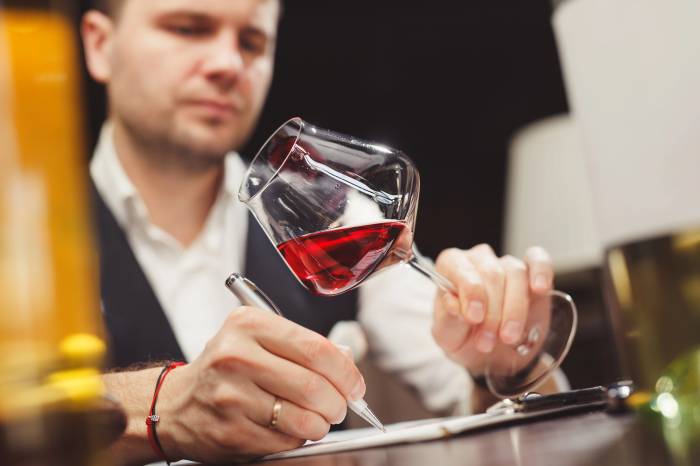Wine tasting blends science and tradition in sensory analysis
Experts use sight, smell, and taste to evaluate wine quality and characteristics, shaping industry standards and consumer appreciation

Wine tasting is a detailed process that goes beyond simply drinking or enjoying a glass of wine. It is a sensory analysis, known in technical terms as an organoleptic analysis, which uses human senses—sight, smell, and taste—to evaluate the properties and characteristics of wine. This method is widely used by professionals in the wine industry to determine the quality and specific attributes of each bottle.
The first step in wine tasting is the visual phase. This begins as soon as the wine is poured into a transparent, clean glass, ideally observed against a white background. The visual examination provides immediate information about the wine’s age, grape variety, and general condition. Four main attributes are assessed: clarity and brightness, fluidity or texture, presence of bubbles, and color. Clarity refers to the absence of suspended particles; a good wine should never appear cloudy. Brightness indicates freshness and acidity, especially in white and rosé wines. Fluidity is observed by swirling the glass and watching how the wine forms “tears” or droplets on the sides; this can indicate alcohol content or residual sugar. Bubbles are essential in sparkling wines but are usually a negative sign in still wines unless intentionally left for freshness in some young whites or rosés. Color offers clues about grape variety, winemaking methods, and age. For example, red wines lighten with age while whites darken.
After the visual assessment comes the olfactory phase. Smell plays a crucial role in wine tasting—about 75% of what we perceive as flavor actually comes from aroma. The sense of smell is highly sensitive but also quick to tire, so it is important to smell the wine immediately after pouring and avoid external odors that could interfere with perception. Aromas in wine are classified into three groups: primary (from the grape), secondary (from fermentation), and tertiary (from aging in barrel or bottle). Primary aromas are often floral or fruity and are detected without swirling the glass. Secondary aromas emerge after swirling, releasing scents related to yeast or fermentation processes. Tertiary aromas develop during aging and can include notes like vanilla, tobacco, or toasted nuts. Negative odors such as sulfur, mustiness from cork taint, or oxidation are also identified at this stage and can indicate faults.
The final step is the gustatory phase, where the wine is tasted. Professional tasters often do not swallow but rather move the wine around their mouth to analyze its flavors and textures before spitting it out. The tongue detects four basic tastes: sweet, salty, acidic, and bitter—each perceived on different areas of the tongue. However, tasting also involves tactile sensations such as body (the weight or fullness of the wine), texture (smoothness or roughness), temperature, and effervescence for sparkling wines. Aromas continue to play a role through retronasal perception as volatile compounds travel from the mouth to the nose.
During tasting, three moments are considered: entry (the first impression), evolution (how flavors develop while holding the wine in the mouth), and finish (the lingering aftertaste once swallowed or spat out). Young red wines may feel rough due to tannins but offer intense fruit flavors that fade quickly. Older wines tend to be smoother with more complex aromas that persist longer on the palate.
Wine tasting requires concentration and practice to identify subtle differences between wines. Professionals use standardized tasting sheets to record their impressions systematically. Over time, both amateurs and experts can train their senses by regularly smelling everyday items and memorizing their scents—a skill that enhances their ability to detect nuances in wine.
The process of organoleptic analysis is fundamental for winemakers, sommeliers, critics, and enthusiasts who seek to understand what makes each wine unique. It allows for objective evaluation based on sensory evidence rather than personal preference alone. In professional settings such as competitions or quality control labs, these methods ensure consistency and help maintain high standards across vintages and producers.
Wine tasting events are held worldwide throughout the year in vineyards, wineries, restaurants, and specialized fairs. These gatherings provide opportunities for education and appreciation while promoting tourism in major wine regions such as Napa Valley in California or Willamette Valley in Oregon.
The art of tasting wine continues to evolve with advances in viticulture and enology but remains rooted in careful observation using sight, smell, and taste—the same senses humans have relied on for centuries to judge food and drink quality. Whether for professional assessment or personal enjoyment, understanding each phase of tasting enriches the experience of every glass poured.
Founded in 2007, Vinetur® is a registered trademark of VGSC S.L. with a long history in the wine industry.
VGSC, S.L. with VAT number B70255591 is a spanish company legally registered in the Commercial Register of the city of Santiago de Compostela, with registration number: Bulletin 181, Reference 356049 in Volume 13, Page 107, Section 6, Sheet 45028, Entry 2.
Email: [email protected]
Headquarters and offices located in Vilagarcia de Arousa, Spain.